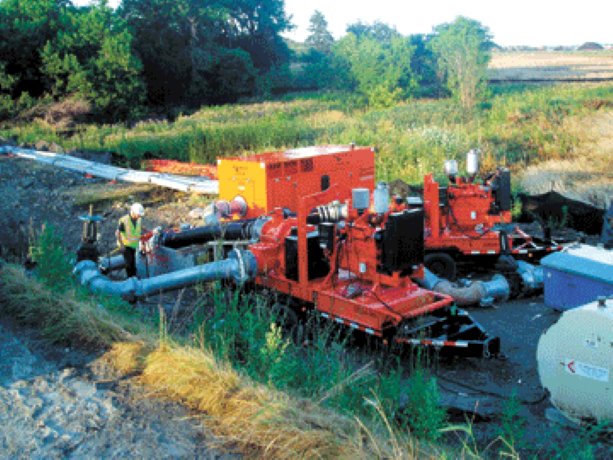A recent sewer tunneling project undertaken along Highway 50 in Bolton, Ontario, northwest of Toronto, took construction along an environmentally sensitive creek. The main contractor was tunneling specialist Dibco Underground Ltd., which was building an expanded capacity sewer line on behalf of its client, the Region of Peel. The dewatering sub-contractor was Aquatech Dewatering Co.
When a major sanitary sewer by-pass is required to complete a construction contract, matching pump capacity to the variable rates of sewage flow is critical. That was especially true on a recent sewer tunneling project undertaken along Highway 50 in Bolton, Ontario, which took construction along an environmentally sensitive creek.
The main contractor on the project was tunneling specialist Dibco Underground Ltd. of Bolton. The company was building an expanded capacity sewer line on behalf of its client, the Region of Peel. The dewatering sub-contractor was Aquatech Dewatering Co. with headquarters in Concord.
“The project took place in October 2011,” says Russell Thomas, project manager and estimator with Aquatech. “Based on the normal level of sewage flows, we were expecting volumes ranging anywhere from 240 litres per second to 440 litres per second, often within the same day.
“We also had to consider the possibility of infiltration during a heavy rain event that would boost those fluid volumes to worst-case peak flows. The system we were asked to design was required to maintain the capacity of the sanitary system to ensure no negative impacts to the adjacent creek. In addition, the system was designed to be completely automated to adjust for variations in flow for up to a month or more.”
While Aquatech often applies for environmental permits on behalf of the client, the Region of Peel had already sought the appropriate clearance from all levels of government before the contractor arrived on scene. It was the contractor’s responsibility to ensure that the job design met the requirements of the permits.
■ Daily Commercial News subscribers may view more information on the Regional Municipality of Peel and its construction projects by viewing company ID 111051 in Reed Construction Data Canada Building Reports.
If you are not already a subscriber, you can be by filling out the form at this web page.
Building Reports are published daily in the Daily Commercial News. The Daily Top 10 Construction projects can be viewed online free of charge at the Reed Construction Data Canada Building Reports web page.
To learn more about construction project leads from Reed Construction Data, fill out the web form at this web page.
“When it comes to wastewater bypasses involving raw sewage, the organization brought in to do the work is chosen through a selection process that doesn’t rely solely on cost,” says Aquatech president, Andy Ingriselli. “Companies are first prequalified based on the capability and depth of the organization, its knowledge of environmental regulations and the skill of its staff to take that complete flow and successfully divert it. You need to demonstrate a consistent track record in previous projects. Anything less and the client risks facing a catastrophic environmental impact.”
Rather than supplying one large pump, the dewatering contractor provided a series of three 12-inch centrifugal pumps. A single pump could handle the lowest level of flows and as sanitary sewer volumes rose, the second pump would kick in to assist. The third pump was used as a mechanical back-up, in case either of the first two pumps faltered for any reason.
“We wouldn’t go with a single large pump that could handle the entire capacity, because it would struggle during the lower flows when operating outside its normal optimum operating range,” says Ingriselli. “The pump simply doesn’t like to operate at water volume levels below its design specifications. That not only consumes too much energy, but will also bog down the engine and can eventually cause serious mechanical problems. “Even when the pump takes prime, a big engine will take that fluid and begin to surge, throwing it out the other side with a hammering effect that could cause problems on the receiving end.”
Traffic control was performed by Dibco as a crew of four Aquatech specialists created the manhole-to-manhole connection, using about 1,000 feet of thin-wall, galvanized steel quick-disconnect pipe. A steel basket strainer was placed on one end of the suction hose to strain out solids above a certain size.
“The system performed as designed for the length of the project, approximately one month,” says Ingriselli. “Peak flows occurred as expected, usually right after the dinner hour, and nothing spilled on the flood plain or into the waterway. It went off without a hitch.”



Recent Comments
comments for this post are closed